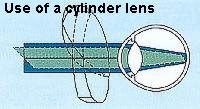Astigmatism
 Distorted or blurred vision usually occurs when the cornea has an irregular curvature. The eye is unable to clearly transmit horizontal, vertical or diagonal lines. This disturbance is called astigmatism and can occur in combination with other conditions such as short-sightedness, far-sightedness or presbyopia.
Distorted or blurred vision usually occurs when the cornea has an irregular curvature. The eye is unable to clearly transmit horizontal, vertical or diagonal lines. This disturbance is called astigmatism and can occur in combination with other conditions such as short-sightedness, far-sightedness or presbyopia.
What are the first signs?
People with astigmatism will often confuse letters with similar strokes such as H, M and N or numbers such as 8 and 0. In combination with short- or far-sightedness, astigmatism can cause eye fatigue or headaches.
And what can you do about it?
 The corrective lenses needed for astigmatism are called Toric lenses and they have an additional power element called a cylinder. You can recognise a Toric lens because the thickness of the edge varies. The greater the degree of astigmatism, the more the lens will vary in thickness. Modern lenses in combination with a small frame now help to reduce such variation. See External Lenses
The corrective lenses needed for astigmatism are called Toric lenses and they have an additional power element called a cylinder. You can recognise a Toric lens because the thickness of the edge varies. The greater the degree of astigmatism, the more the lens will vary in thickness. Modern lenses in combination with a small frame now help to reduce such variation. See External Lenses
A better focus on the world
With modern high-performance material at our disposal, even eyeglasses to correct astigmatism can be stylishly fashioned to be thinner, lighter and flatter than the eyeglasses of old. We will fit lenses depending on the combination with other corrective needs (short- or far-sightedness, presbyopia).
Eyeglasses are all available with a variety of anti-reflective coatings and speciality tints or photochromic options. If you choose hard-resin lenses, it is advisable to add a scratch-resistant coating.
Thanks to advancements in technology, most people with astigmatism can now be fitted with contact lenses which correct a slight or strong degree of astigmatism in combination with short-sightedness, far-sightedness or presbyopia. Contact lenses will give you a natural look, clear vision in any situation and a wide field of vision.


